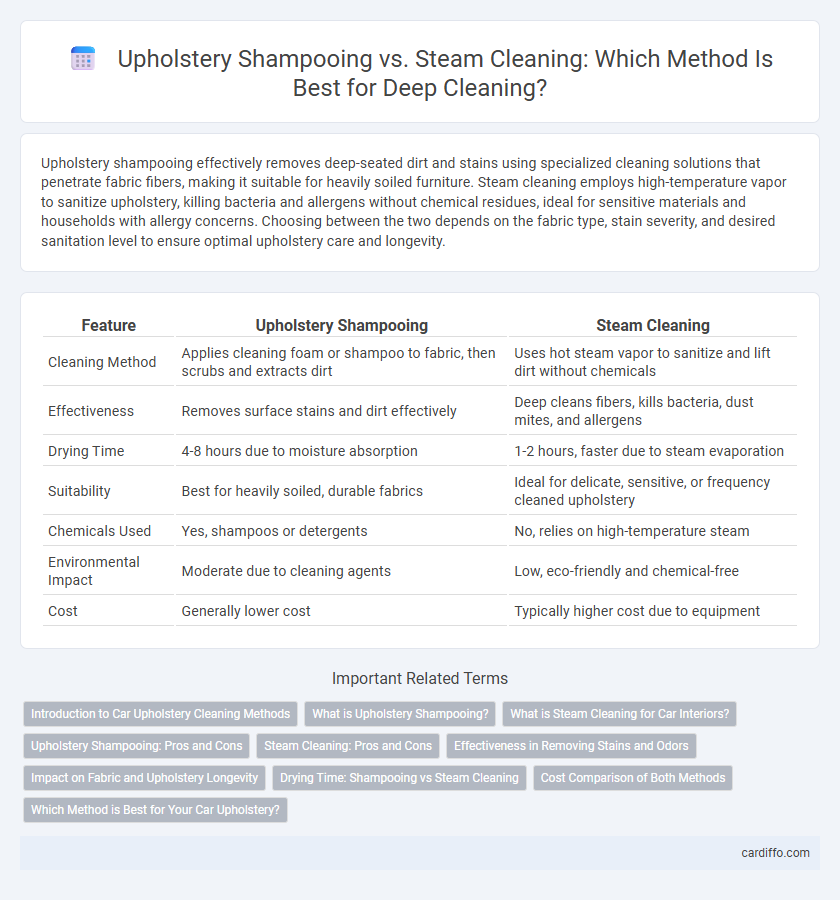Upholstery shampooing effectively removes deep-seated dirt and stains using specialized cleaning solutions that penetrate fabric fibers, making it suitable for heavily soiled furniture. Steam cleaning employs high-temperature vapor to sanitize upholstery, killing bacteria and allergens without chemical residues, ideal for sensitive materials and households with allergy concerns. Choosing between the two depends on the fabric type, stain severity, and desired sanitation level to ensure optimal upholstery care and longevity.
Table of Comparison
| Feature | Upholstery Shampooing | Steam Cleaning |
|---|---|---|
| Cleaning Method | Applies cleaning foam or shampoo to fabric, then scrubs and extracts dirt | Uses hot steam vapor to sanitize and lift dirt without chemicals |
| Effectiveness | Removes surface stains and dirt effectively | Deep cleans fibers, kills bacteria, dust mites, and allergens |
| Drying Time | 4-8 hours due to moisture absorption | 1-2 hours, faster due to steam evaporation |
| Suitability | Best for heavily soiled, durable fabrics | Ideal for delicate, sensitive, or frequency cleaned upholstery |
| Chemicals Used | Yes, shampoos or detergents | No, relies on high-temperature steam |
| Environmental Impact | Moderate due to cleaning agents | Low, eco-friendly and chemical-free |
| Cost | Generally lower cost | Typically higher cost due to equipment |
Introduction to Car Upholstery Cleaning Methods
Car upholstery cleaning methods include upholstery shampooing and steam cleaning, each offering distinct advantages for maintaining vehicle interiors. Upholstery shampooing involves applying specialized cleaning solutions to lift dirt and stains from fabric surfaces, effectively restoring appearance without moisture damage. Steam cleaning uses high-temperature vapor to sanitize and remove deeply embedded grime, ensuring thorough disinfection while minimizing chemical use.
What is Upholstery Shampooing?
Upholstery shampooing is a deep-cleaning method that uses specially formulated cleaning foams or shampoos to remove dirt, stains, and allergens from fabric furniture. This technique involves applying the shampoo, scrubbing gently with a brush, and then extracting the dissolved dirt with a wet vacuum. Upholstery shampooing is particularly effective for heavily soiled fabrics and helps restore vibrancy while ensuring fiber protection.
What is Steam Cleaning for Car Interiors?
Steam cleaning for car interiors uses high-temperature steam to penetrate and lift dirt, grime, and bacteria from fabric and surfaces without chemicals. This method sanitizes upholstery and carpets effectively, reducing allergens and odors while preserving delicate materials. Compared to upholstery shampooing, steam cleaning offers a deeper, eco-friendly clean with faster drying times.
Upholstery Shampooing: Pros and Cons
Upholstery shampooing effectively removes deep-seated dirt and stains by using specialized cleaning solutions that penetrate fabric fibers, making it ideal for heavily soiled furniture. This method can enhance fabric color and texture but requires thorough drying to prevent mold growth and may leave residue if not properly rinsed. Compared to steam cleaning, upholstery shampooing offers a stronger cleaning action on tough stains but tends to take longer to dry and may not be suitable for delicate or moisture-sensitive materials.
Steam Cleaning: Pros and Cons
Steam cleaning offers deep sanitization by penetrating fabric fibers, effectively removing dirt, allergens, and bacteria without harsh chemicals. It rapidly dries upholstery, reducing the risk of mold and mildew growth compared to traditional shampooing methods. However, steam cleaning can be less effective on tough stains and may cause damage to delicate or non-water-resistant fabrics.
Effectiveness in Removing Stains and Odors
Upholstery shampooing effectively removes surface stains and embedded dirt through deep scrubbing and specialized cleaning agents, making it ideal for heavily soiled fabrics. Steam cleaning penetrates fabric fibers using high-temperature vapor, which kills bacteria and eliminates odors without the risk of over-wetting, preserving upholstery integrity. Both methods excel in stain and odor removal, but steam cleaning offers superior sanitation and faster drying times compared to traditional shampooing.
Impact on Fabric and Upholstery Longevity
Upholstery shampooing involves applying a foamy cleanser that penetrates fabric fibers to remove dirt and stains, which can sometimes leave residues that attract dirt over time and potentially degrade fabric integrity. Steam cleaning uses high-temperature vapor to deeply cleanse without chemical residues, effectively killing bacteria and mites while minimizing fabric stress, thereby enhancing upholstery longevity. Choosing steam cleaning generally results in gentler care and prolonged life for delicate fabrics compared to the more abrasive shampooing method.
Drying Time: Shampooing vs Steam Cleaning
Upholstery shampooing typically requires a longer drying time, often between 6 to 12 hours, due to the amount of moisture absorbed by the fabric during the process. Steam cleaning, on the other hand, uses high-temperature vapor that evaporates quickly, often drying in 1 to 3 hours, reducing downtime for furniture use. Choosing between shampooing and steam cleaning depends on balancing thorough stain removal with the need for faster drying times in upholstery care.
Cost Comparison of Both Methods
Upholstery shampooing generally incurs lower upfront costs, averaging between $50 and $150 per session, while steam cleaning tends to range from $80 to $250 due to specialized equipment. Shampooing often requires more frequent treatments since it may not eliminate deep-seated dirt as effectively as steam cleaning, potentially increasing long-term expenses. Steam cleaning delivers a more thorough sanitization, reducing the need for repeat cleanings and offering better value despite the higher initial price.
Which Method is Best for Your Car Upholstery?
Upholstery shampooing uses a foamy detergent to deeply clean fabric car seats, effectively removing dirt and stains while adding a fresh scent. Steam cleaning employs high-temperature vapor to sanitize and loosen grime without harsh chemicals, ideal for delicate or synthetic materials. Choosing the best method depends on your car upholstery type and stain severity; for heavy stains on durable fabrics, shampooing is preferred, while steam cleaning is safer for sensitive or lightly soiled surfaces.
Upholstery shampooing vs Steam cleaning Infographic

 cardiffo.com
cardiffo.com